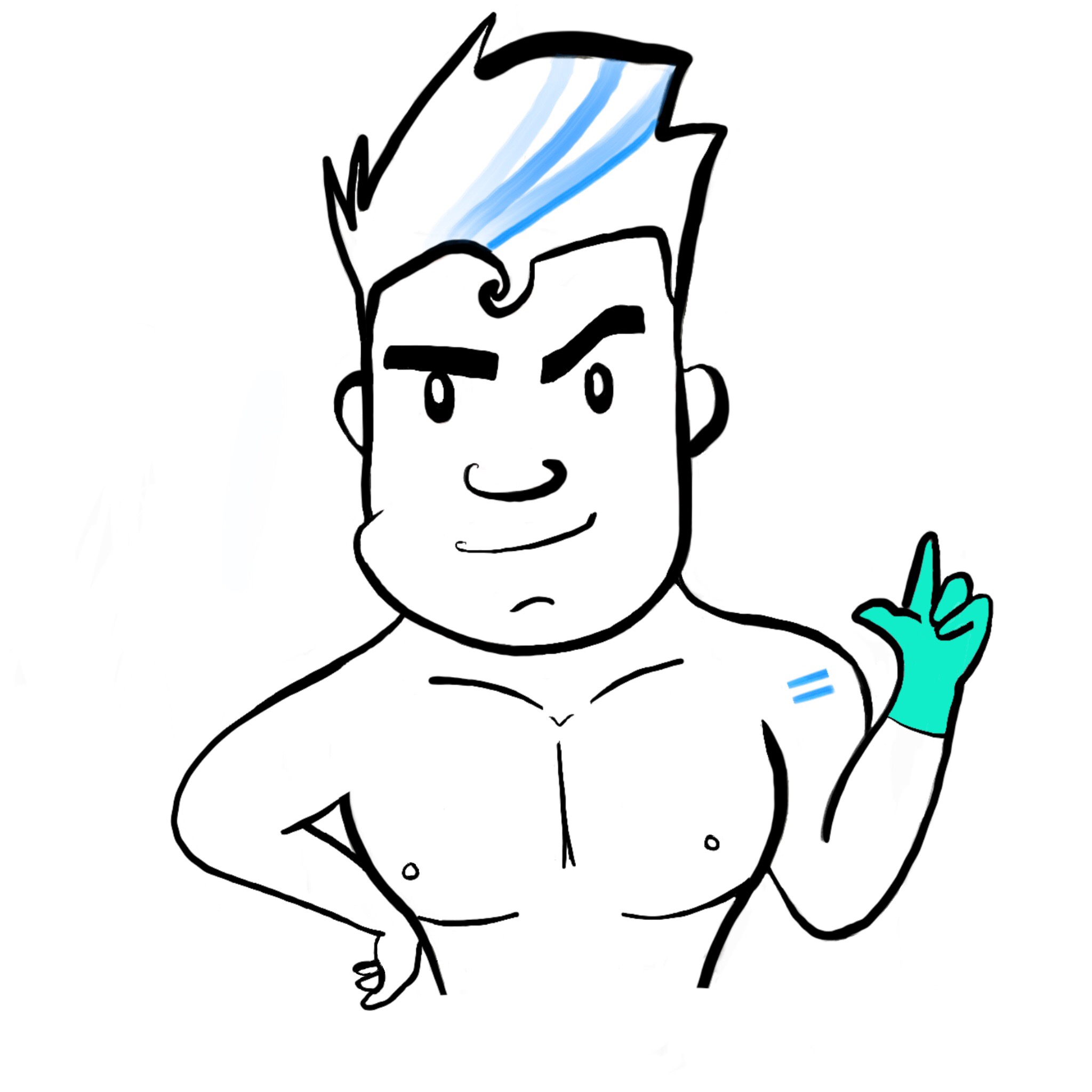
My Prostate
What is it?
Your prostate is a gland that is located at the very base of your penis and surrounds your urethra, the tube you pee and ejaculate through, as it exits your bladder. The prostate is the size of a walnut and lies against the wall of the rectum, and so can be felt on the front side when placing a finger in the rectum. The prostate has a number of functions that contribute to your general and sexual health.

- The prostate makes the milky, white fluid that is combined with your sperm and other fluids to produce semen, or cum. During an orgasm, sperm stored in seminal vesicles is transferred into the urethra. Muscles in the prostate contract to pump the prostatic fluid into the urethra adding it to the sperm, and together these are ejaculated as cum.
- The prostate can be sensitive to touch, and the pumping action during orgasm that ejects fluid into the urethra and shoots semen out of the penis causes considerable pleasure. Some men can achieve orgasm simply by massaging the prostate through the wall of the rectum.
- The prostate also directs traffic; it has two valves, or sphincters, to control the flow of urine and semen. The upper sphincter, where the prostate and bladder meet, controls the flow of urine and remains closed until you have the opportunity to pee. This sphincter also closes during orgasm, ensuring semen shoots out through the penis and not backwards into the bladder. The lower sphincter, at the base of the prostate where the urethra exits, is the one you have control over. We can close this valve to prevent peeing when it is not an appropriate time to go. If this valve is damaged during prostate surgery, urine may leak out resulting in incontinence. The lower sphincter can also be controlled to delay orgasm. Holding this valve closed during sex is what many men refer to as “edging,” delaying ejaculation until final release with intense orgasm.
- The prostate also produces the enzyme, 5-alpha-reductase, that converts testosterone to its more potent form, dihydrotestosterone (DHT). Both testosterone and DHT enhance sexual arousal and desire, increase muscle and bone mass, and contribute to a sense of health and well-being.
Potential Prostate Problems
An enlarged prostate is generally the result of Benign Prostate Hypertrophy (BPH). The prostate is shaped somewhat like a donut, and as it increases in size it can squeeze off the urethra passing through its center; this can make it difficult to pee. BPH can occur as early as age 40, and becomes more common as men get older.
Prostatitis means inflammation of the prostate. Symptoms typically include fever, pain, and discomfort at the base of the penis, with worsening pain during urination. Prostatitis may be caused by a bacterial infection, and can be either acute (rapid in onset) or chronic (lasting for a prolonged period of time). Bacterial prostatitis is treated with antibiotics.
Prostadynia, or chronic pelvic pain syndrome (CPPS), refers to pain in the prostate. The cause of CPPS is unknown, but may be the result of muscle spasm within the prostate gland. CPPS is sometimes treated with beta-blockers or muscle relaxants.
Prostate cancer is the most common cancer affecting Canadian men. It is estimated that 1 in 8 men will be diagnosed with prostate cancer in their lifetime. The risk of developing prostate cancer increases with age, with the majority of cases occurring in men over the age of 70. Prostate cancer occurs when cells within the prostate begin to grow abnormally, causing one portion of the prostate to increase in size. This is distinct from the normal prostate enlargement that occurs with age, where the prostate increases uniformly in size. Men over the age of 50, and men whose father or brother has prostate cancer, should be screened every 1-2 years. Screening is done by your doctor inserting a gloved finger in your rectum to feel the size and contour of your prostate, and may also involve a blood test known as a PSA (Prostate Specific Antigen) test. Ultimately, prostate cancer is diagnosed with a biopsy.
Prostatitis
Prostatitis simply means inflammation of the prostate. It can be the result of a bacterial infection, inflammation after a bacterial infection, or just inflammation of the prostate without infection.
There are three main types of prostatitis. The first is acute bacterial prostatitis. Bacteria can reach the prostate by traveling up the urethra, the tube that you pee through. Common bacteria that can cause prostatitis include E. coli, which can also cause bladder infections. Sexually transmitted infections, like gonorrhea and chlamydia, can also sometimes cause prostatitis. Symptoms of acute bacterial prostatitis are often very sudden in onset, and can include frequent urination, urgency (the need to pee right away), burning with peeing, fever or chills, or perineal discomfort (that’s the area between your anus and your scrotum). This type of prostatitis requires prompt medical attention and antibiotics.
The second type is chronic bacterial prostatitis. In this type, the bacteria cause a low grade, persistent infection. Symptoms can include again perineal discomfort or “feeling like I am sitting on a golf ball”, frequent urination, urgency, and sometimes low back pain. Fever is not a part of chronic bacterial prostatitis. Chronic bacterial prostatitis often occurs after acute bacterial prostatitis.
The third type of prostatitis is called nonbacterial prostatitis, or chronic pelvic pain syndrome (CPPS). CPPS is by far the most common cause of prostatitis, and is responsible for over 90% of all cases. Symptoms are very similar to chronic bacterial prostatitis. Guys often complain of pain in the genitals, a “heaviness or aching down there,” frequent peeing, trouble peeing, and a slow stream. Guys with CPPS often find that they have good and bad days.
As far as treatment goes, if prostatitis is caused by a bacterial infection antibiotics are a must. However, it can be very difficult to prove whether or not there are bacteria in the prostate. For example, if a urine culture grows bacteria, there is no way to know for sure whether the bacteria are from a bladder infection or a prostate infection. As a result, if bacterial prostatitis is suspected, a course of antibiotics is recommended.
Because antibiotics do not easily enter the prostate, a prolonged course of treatment is required. Acute bacterial prostatitis is usually treated with antibiotics for 6 weeks. Chronic bacterial prostatitis usually requires about 12 weeks (3 months) of antibiotics. If you have bacterial prostatitis, it is very important that you complete the full course of treatment prescribed by your doctor. This cannot be over emphasized, cutting the treatment time short and not taking the full course of antibiotics can lead to recurrence and make treating prostatitis increasingly more difficult. For example, not taking the full 6 weeks of antibiotics prescribed for acute prostatitis is often what leads to chronic prostatitis.
Nonbacterial prostatitis, or chronic pelvic pain syndrome, unfortunately, can be difficult. Treatment options include phytotherapy (such as saw palmetto, quercertin, bee pollen extracts), pelvic floor physiotherapy, biofeedback, anti-inflammatories, and stress reduction.
Many men may also respond to medications such as Flomax, Xatral, and Rapaflo to help with reduced urine flow from all types of prostatitis.
Prostate cancer
Prostate cancer occurs when cells within the prostate begin to grow abnormally, causing one portion of the prostate to increase in size. This is distinct from the normal prostate enlargement that occurs as men age, where the prostate increases uniformly in size. Often, prostate cancer grows very slowly, but with time the cancer cells may escape the prostate and spread to other parts of the body.
Every man worries about prostate cancer at some point in his life. It is one of the most common cancers in men. The chance of getting prostate cancer increases with age and occurs in about 70% of men over the age of 80. Unfortunately prostate cancer has no early warning signs or symptoms and most men with prostate cancer say “I feel fine”. On the positive side, prostate cancer grows extremely slowly and when it is found early enough there are great treatment options. Given how slow this cancer grows, the older you are when it is detected, it may not even need to be treated.
Possible causes of prostate cancer include high fatty diets, BBQ’d meats, lack of exercise, and genetics… your risk is higher if your father or brother(s) have prostate cancer. Your risk is also higher if you are Black.
The symptoms of prostate cancer are much the same as those with normal prostate enlargement. These include urinating more frequently, slower urinary stream, decreased force or pressure to your stream, some hesitancy in starting your stream or straining, stream starts and stops, or feelings of incomplete emptying of your bladder. Blood in your urine may be another sign.
Men over the age of 50 and men whose father or brother has prostate cancer should be screened every 1-2 years. Screening is done by your doctor inserting a gloved finger in your rectum to feel the size and contour of your prostate and may also involve a blood test known as a PSA (Prostate Specific Antigen) test. As you may know, screening for prostate cancer with a PSA blood test can be controversial for many reasons, and often misunderstood and reported as such by the media. Ultimately, prostate cancer is diagnosed with a biopsy.
Treatment of prostate cancer depends on many factors such as how aggressive the cancer is, whether it is confined to the prostate or has spread to other parts of the body, as well as the patient’s age and general health. Treatment options include just monitoring things, beam radiation, seed radiation, and surgery. The main potential side effects of all treatments can be incontinence (trouble controlling your urine) and erectile dysfunction (difficulty getting or maintaining an erection). The decision on treatment is definitely one you need to make with a Urologist.